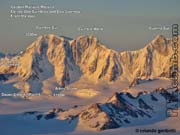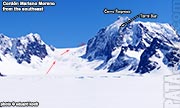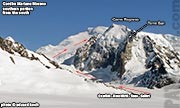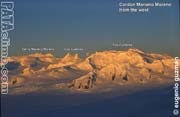| Cordón Mariano MorenoDos Cuernos Dos CumbresGemelos Blancos & Cerro RegresoWhere to find more information |
Update: last updated on 08/12/2017. Cordón Mariano Moreno (ca. 3500m). Cordón Mariano Moreno is located in the heart of the Ice Cap, 25km west of the Cerro Torre Group, separated from the Pacific Ocean fjords by the Altiplano Caupolicán. The name remembers an argentine lawyer, journalist and politician (1778-1811) who played an important role in the first national government of Argentina. A long biography here. It was christened by Alfred Kölliker and partners in 1915. The main, highest summit is called Cerro Francisco P. Moreno after "Perito" Moreno, the well know Argentine academic, explorer and surveyor (no relation to Mariano Moreno), is of relatively little interest to climbers, but it is a great mountaineering adventure. Most ascents are done with skis, at least until quite close to the summit, where "rime angel wings" on the surface can make skiing uncomfortable or in some cases impossible. The first ascent of Cerro Francisco P. Moreno and the entire range was done by Walter Bonatti and Carlo Mauri (IT), with Folco Doro Altán (AR-IT) and René Eggmann (AR) in February of 1958. They completed the ascent in 30 hours round-trip from a camp below the west face of the Cordón Adela. There are many routes possible to the main summit from the east, all of them of equal difficulty, involving snow to 35˚ and some tricky sections to overcome crevasse mazes. The easiest possible route is from the north, up a shallow valley that enters the mountain to the west of Paso de los Cuatro Glaciares and Paso Moreno. This is by far the longest of all routes, but it has few if any crevasses. It was first done by Miguel Angel Alonso, Valeria de la Fuente & Alfredo Rosasco, in May 1997; and later solo (Rolando Garibotti 9/2001). The areas of interest to the climber lie to the south, on the east faces of sub-summits Dos Cuernos and Dos Cumbres and on the east ridge of Gemelos Blancos. There has been some talk about a traverse of the entire Cordón. In spite of not presenting technical difficulties this could be an interesting objective, likely one to do with skis so as to facilitate the approach and the return, although on the summit ridges, because of heavy rime it is unlikely that they could be used. Likely it makes more sense to do the traverse from north to south, from the Paso Moreno to Paso Rokko. It would surely be a great adventure. We have included a number of images showing the west side of the massif. That side is completely virgin. Although not particularly challenging technically it would surely yield some great experiences. In November of 2004 Amy Bullard, Peter Carse (US) and Karen McNeill (NZ) did the first ascent of the higher Cuerno Norte. Because of high temperatures they abandoned their original idea of climbing the east face and tackled the safest line they could find, climbing the southeast ridge of an unnamed sub-summit (2800m) to the north and slightly east, to then follow the north ridge of Cuerno Norte to the summit. Their route is long (1500m elevation gain and 5km in length), but is relatively safe, highly scenic, and quite moderate. They encountered chossy rock to 4th class, snow to 45° and ice to WI2. They found passage through the summit mushroom on the northwest side. It took them nine hours for the ascent and five hours to descend the same way. The lower Cuerno Sur remains unclimbed. In the 1972-73 season Jorge Aikes, Eduardo Rodriguez (AR), Martin Schliessler and Günter Sturm (DE) climbed two new routes doing the first ascent of the peak, climbing the higher south summit. Rodríguez and Schliessler climbed a line via a col immediately south of the peak, a line with little technical difficulty. Aikes and Sturm climbed an obvious snow ridge in the east face. It took them 14 hours from the base to the top, reaching the summit in the late evening. As they climbed a ferocious storm started and when they reached the summit they were forced to bivy three nights in a snow hole before they were able to descend via the Rodríguez-Schliessler line. They simul-climbed most of the route except for a few short sections where they belayed. The ascent took them 12 days round trip from Estancia Túnel. In 2008 a film was made about Schliessler's life, a well known film maker and the film includes images from these ascents. Apparently he had a camera with him in 1972. Details about this ascent were sketchy until late 2013 when we contacted Aikes. He recalled climbing the difficult ridge to the right. Surprised that such a hard climb would have been done in the 70s and would not have been reported more widely we contacted Stürm who went on to correct Aikes' recollections and point that they climbed the ridge on the left, a fact confirmed by two articles published at the time of the ascent that he was kind enough to forward. The Aikes-Stürm line was repeated in November of 2000 by Tom Dauer and Michi Wärthl (DE), with Stephan Siegrist (CH). They found difficulties to M5 and 75˚ and used the rope only to descend. In 1966 Carlos Comesaña had made an attempt on that line. He was with Nestor Apraiz, Fernando Bosch, Alfredo Fragueiro and Ismael Palma (AR). During the same trip Comesaña and Palma did the first ascent of Aguja T-48 in the Agujas del Río Túnel Group. It was Comesaña that provided Aikes and partners the info of how to get there. The Cumbre Norte, which is lower, remains unclimbed.
The Gemelos Blancos themselves are rather uninteresting, big snow blobs, but the east and southeast ridges that stretch out into the Viedma Glacier have some impressive faces, including one un-named virgin two-tier tower that looks to be about 800 meters tall. For practical purposes we call it here "Torre Sur" because of its location within the Cordón Mariano Moreno. This looks like a very interesting objective. The rock appears vastly different from the Mariano Moreno Range, far better, offering steep and difficult climbing in an impressive setting, not that far away from civilization. The base is around 35 to 40km away from Paso Marconi, a distance that in good conditions can be covered in a day and a half, perhaps in only a few hours if using a kite. The summit immediately west of Torre Sur, a big snowy peak, 2695 m, S49°27.127' W73°27.304', was climbed in September of 2014 by Germans Franz Goerlich, Robert Koschitzki, Paul Sass and Uwe Seifert. They used skis and skied down the west face finding powder conditions. They christened it Cerro Regreso.
Buy a copy of Silvia Metzeltin and Gino Buscaini's book: Patagonia: Terra Magica per Alpinisti e Viaggiatori (Dall'Oglio, Milano, 1987). The Italian version can be purchased via Amazon. It is an excellent book, well worth every penny. The Spanish version published by Ediciones Desnivel is of much lesser quality than the original and has many translation mistakes. For anyone that might be climbing un-named virgin summits in the area and before concocting any new toponyms I suggest and plea that you read Evelio Echeverria's awesome essay about the subject. It is a must and it is important to heed his advise. Read here. Evelio is a very well respected mountaineer and explorer, who has dedicated decades to exploring the Chilean and Argentine Andes. He is the author of Chile Andinista: Su Historia, Santiago de Chile, 1999. It is not ok to name geographic points after yourself, after religious figures (De Agostini has already done that enough), people that are alive (unless it is your mommy - much respect Mr. Kölliker...) or places or people that have nothing to do with the area. Descriptive names are always the safest, less controversial option and will get accepted easily.
|
Photos (click to enlarge) 
Cordón Mariano Moreno - overview 
Cordón Mariano Moreno from the east 
Dos Cumbres from the east 
Dos Cumbres and Dos Cuernos from 
Cerro Regreso and the un-climbed 
Cerro Regreso and the un-climbed 
The un-climbed "Torre Sur" from the 
Cordón Mariano Moreno from the west 
Cordón Mariano Moreno from the west |
SITEMAP
If you find this web page useful, please consider making a donation
CLIMBING AREAS |
KNOWLEDGEDISCLAIMER COPYRIGHT CONTACT DONATE |
Climbing is dangerous, take responsibility, climb at your own risk. © 2010 Rolando Garibotti. All rights reserved.